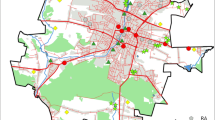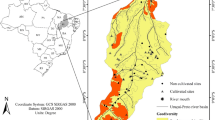Abstract
Nowadays, anthropogenic inflow of heavy metals (HM) into the environment far exceeds their natural quantities in Ukraine. The main sources of HM inflow are enterprises that use high-temperature processes in the production cycle—combustion of fuel and thermal processing of raw materials. Examples of such enterprises are Avdiivka Coke and Chemical Plant (the largest in Europe) and the Zmiiv Thermal Power Plant (the largest in Ukraine), which use high-temperature processes associated with the use of black coal that are considered as important sources of heavy metals in the soil. On the basis of analytical data of 3000 samples of surface layer of Ukrainian soils, which form the basis of the nationwide GIS “Microelements in soils of Ukraine,” it was established that the spatial distribution of the content of accessible forms of copper in the upper soil layer in Ukraine varies greatly and practically does not depend on the type of soil formation and is determined mainly by geochemical factors such as saturation of parent rocks with copper, as well as anthropogenic influence. The emissions from the Avdiivka Coke and Chemical Plant resulted in the formation of a clearly defined contamination range of soil and vegetation by HM in the adjoining territories exceeding the threshold levels of copper. In the zone of influence of the Zmiiv Thermal Power Plant, the technogenic load on agricultural lands is much less and does not exceed the medical and sanitary indicators of the content of heavy metals in the soils, but due to the high pipe height (180–250 m), the toxic emissions of the enterprise dissipate to a large area and form a regional technogenic background of available copper in soils.





Similar content being viewed by others
References
DSTU 4770.6:2007 Soil quality. Determination of copper mobile compounds in soil in buffered ammonium – acetate extract with pH 4,8 by atomic-absorption spectrophotometry. National standard of Ukraine. (2008). Kyiv: State Committee for Technical Regulation and Consumer Policy.
DSTU ISO 10012:2005 Measurement management system –requirements for measurement processed and measuring equipment (ISO 10012:2003, IDТ). National standard of Ukraine. (2007). Kyiv: State Committee for Technical Regulation and Consumer Policy.
DSTU ISO 10381-4:2005 Soil quality –sampling –part 4: guidance on the procedure for investigation of naturel, near-natural and cultivated sites (ISO 10381-4:2003, IDT). National standard of Ukraine. (2007). Kyiv: State Committee for Technical Regulation and Consumer Policy.
FAO (2014). ECE/CEP/2014/14. Guidelines for developing national strategies to use soil contamination monitoring as an environmental policy tool. United Nations Economic and Social Council Distr.: Economic Commission for Europe Committee on Environmental Policy Twentieth session Geneva, 28–31 October 2014 Item 6 of the provisional agenda Environmental monitoring. http://www.unece.org/fileadmin/DAM/env/documents/2014/ece/cep/ece.cep.2014.14.e.pdf [accessed 06.02.18].
FAO (2015). Status of the world’s soil resources, main report. http://www.fao.org/3/a-i5199e.pdf [accessed 28.05.12].
Fatjejev, A. I., & Pashchenko, Y. V. (2001). Soil contamination in the zone of influence of Zmiiv Thermal Power Plant and Balakleevsky cement-slate combine. Agrochemistry and Soil Science. Collected papers, 61, 163–168.
Fatjejev, A. I., & Pashchenko, Y. V. (2003). The background content of trace elements in soils of Ukraine (p. 13). Kharkiv: Drukarnja No.
Gazizullin, I., Lozovy, L., Ivakhno, O., Williams, V., Petrenko, I., & Zayka, R. (2011). Reduction of emissions in the thermal power industry of Ukraine due to fulfillment of the requirements of the European Energy Community. Green book Kyiv: Optima Publishing House.
He, Z., Shentu, J., Yang, X., Baligar, V. C., Zhang, T., & Stoffella, P. J. (2015). Heavy metal contamination of soils: sources, indicators, and assessment. Journal of Environmental Indicators, 9, 17–18.
Kabata-Pendias, A. (2010). Trace elements in soils and plants (4th ed.). Boca Raton, FL: Crc Press.
Liang, J., Feng, C., Zeng, G., Gao, X., Zhong, M., Li, X., Li, X., He, X., & Fang, Y. (2017). Spatial distribution and source identification of heavy metals in surface soils in a typical coal mine city, Lianyuan, China. Environmental Pollution, 225, 681–690.
Lysenko, M.M., Baliuk, S.A. & Fatjejev, A. I (1999) Atomic-absorption methods for the determination of heavy metals in biological objects. In Bulyhin, S.Iu., Baliuk, S.A., Mikhnovska, A.D. & Rozumna, R.A. (Ed.), Methods of analysis of soils and plants (methodical manual) (pp. 107–123). Kharkiv: NSC ISSAR.
National report on the state of the environment in Ukraine in 2014. (2016). Kyiv: Ministry of Environmental Protection of Ukraine, FOP Hrin D.S.
Paschenko, YAV. , Fateev, A.I., Miroshnichenko, N.N. &, Fedorovich, O.M. (2003) Contamination of crops with heavy metals from soil and atmosphere. Agrochemistry and soil science. 2003, 64, 77–85.
Rodríguez-Bocanegra, J., Roca, N., Febrero, A. & Bort, J. (2017). Assessment of heavy metal tolerance in two plant species growing in experimental disturbed polluted urban soil. Journal of Soils and Sediments DOI https://doi.org/10.1007/s11368-017-1666-8. at: https://www.researchgate.net/publication/313255008_Assessment_of_heavy_metal_tolerance_in_two_plant_species_growing_in_experimental_disturbed_polluted_urban_soil [accessed 06.02.18], 18, 2305, 2317.
Rodríguez-Eugenio, N., McLaughlin, M., & Pennock, D. (2018). Soil pollution: a hidden reality. Rome: FAO.
Sahraoui, H., Attia, R., Hamrouni, H., & Hachicha, M. (2016). Assessment of trace elements contamination of agricultural topsoil around Lakhouat mine area, Tunisia. Walailak J Sci & Tech., 13(11), 965–976.
Samokhvalova V.L., Fatjejev A.I., Voron V.P., Luchnikova Ye.V. (2009) Peculiarities of studying and determining the pollution of snow cover by heavy metals in the zones of stable aerotechnogenic emissions of pollutants. Scientific Bulletin of UzhNU, Series: Biology, 26, 111–121.
Zubkovich S.A. (2015). The relationship of natural hydrometeorological phenomena and wind anomalies over eastern Ukraine. Dissertation for the PhD degree in geography. Odesa: OSEU.
Author information
Authors and Affiliations
Corresponding author
Additional information
Publisher’s note
Springer Nature remains neutral with regard to jurisdictional claims in published maps and institutional affiliations.
This article is part of the Topical Collection on Global approaches to assessing, monitoring, mapping and remedying soil pollution
Rights and permissions
About this article
Cite this article
Semenov, D.O., Fatjejev, A.I., Smirnova, K.B. et al. Geochemical and anthropogenic factors of variability of heavy metals content in the soils and crops of Ukraine at the example of copper. Environ Monit Assess 191, 527 (2019). https://doi.org/10.1007/s10661-019-7622-x
Received:
Accepted:
Published:
DOI: https://doi.org/10.1007/s10661-019-7622-x




